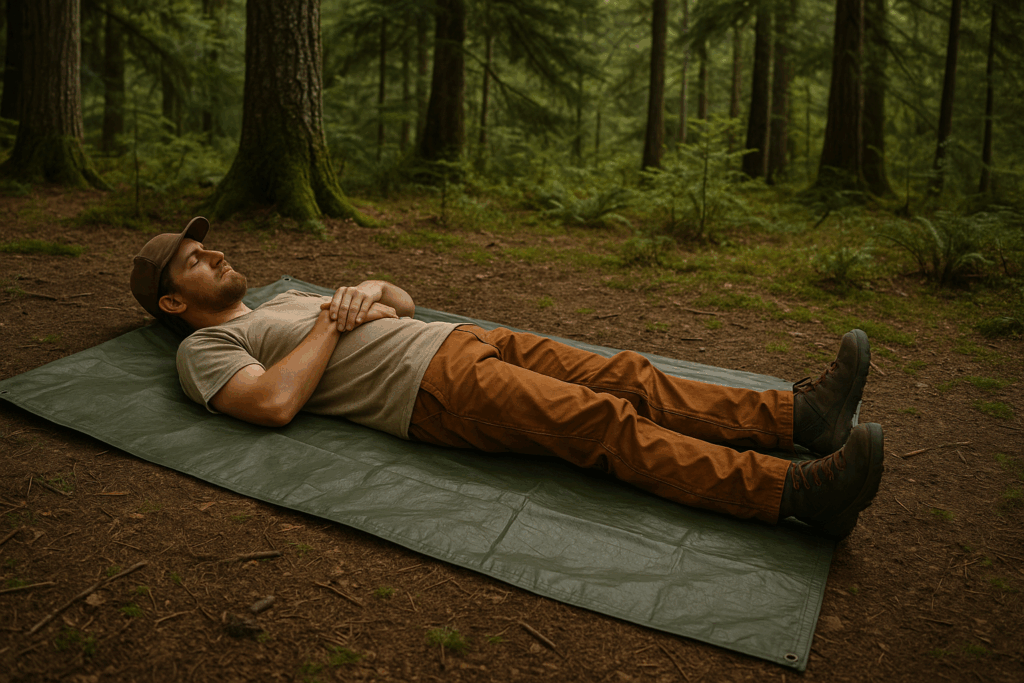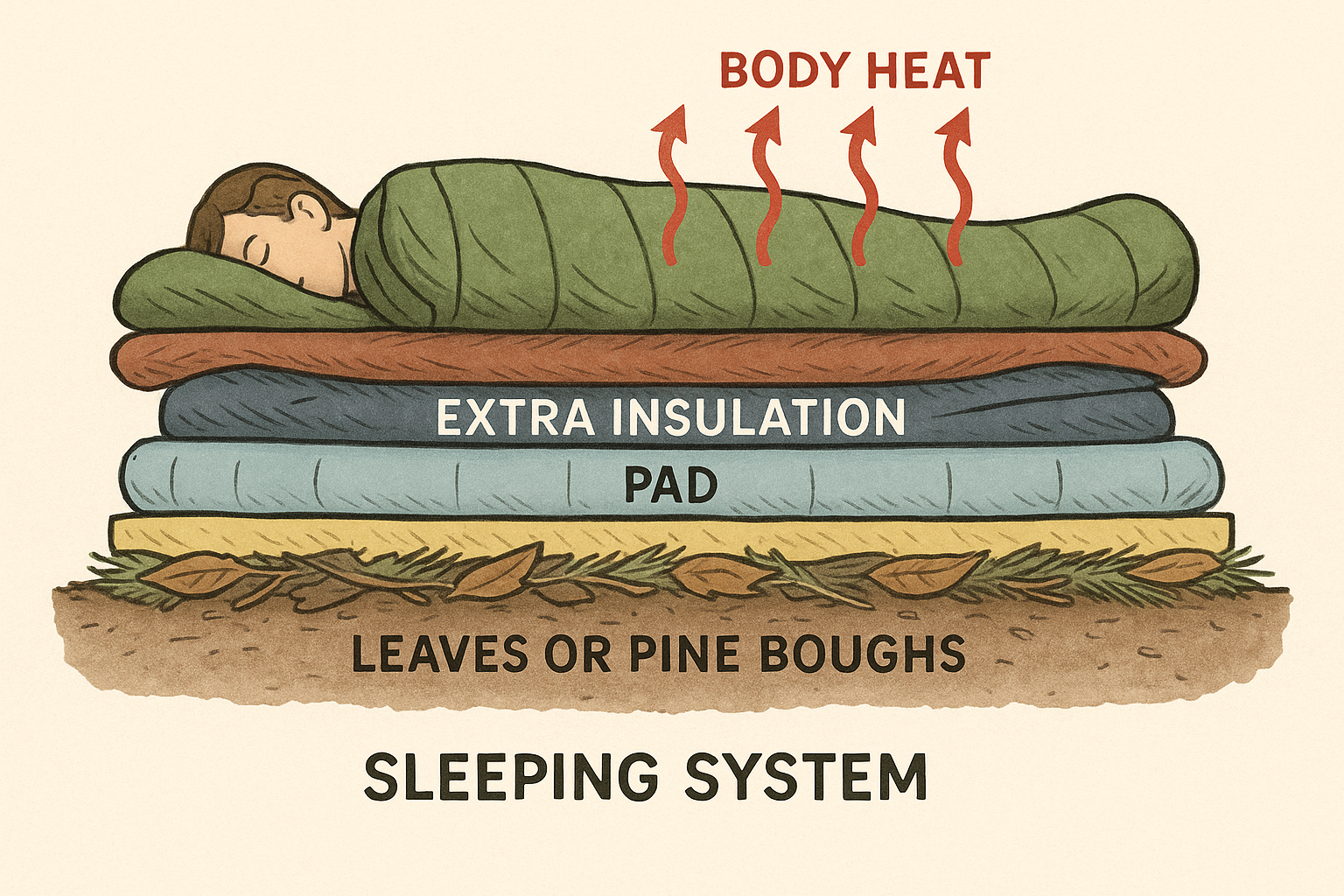You’ve packed the right sleeping bag, a cozy pad, and maybe even your favorite camping pillow. But when night falls, the wind kicks up, and your tent flaps like a sail—you’re wide awake, angry, and colder than you should be.
Truth is, even the best gear can’t save your sleep if your tent setup is off.
These are the tent setup mistakes that quietly ruin your rest—and the smart, often-overlooked fixes that’ll help you sleep like a rock, even in brutal conditions.
😩 Mistake #1: Ignoring Slope Orientation
Many campers focus on flatness. That’s a start—but not the full picture.
Even a slight downhill tilt can cause:
- Your body to slide all night
- Blood to pool in your head (hello, pressure headache)
- Your sleeping pad to curl at the feet
✅ How to Avoid It:
Always lay down on your back before staking your tent. If you feel even a subtle slide, rotate your setup until your head is slightly uphill—never downhill or sideways.
Bonus tip: Use your pack under your pad to correct slants if you’re stuck with sloped ground.

🧱 Mistake #2: Not Clearing the Ground (Below the Surface)
You think you’ve cleared the ground—until 3AM rolls around and something’s digging into your back like nature’s version of a parking boot.
I once camped under a redwood canopy, thinking I’d scored the perfect spot. But I missed a root curled just under the surface like a sleeping snake. That night, every turn bruised my hip like I’d been wrestling the forest floor.
Don’t trust your eyes—trust your palms. Get down, sweep the area, and feel everything. Pack down soft stuff like moss or dry leaves to level tiny divots. Because when the temperature drops, even a pebble can feel like punishment.
Surface checks don’t cut it. Poorly prepped ground leads to:
- Hip bruises
- Shoulder cramps
- Uneven pressure on sleeping pads (causing slow leaks)
✅ How to Avoid It:
Clear a tent-sized area by:
- Scraping the surface with your boot heel or tent stake
- Feeling with open palms, not just your eyes
- Packing divots with dirt, moss, or soft leaves
Even micro-bumps can ruin deep sleep—your body’s sensitive to pressure when it’s cold.
🌬️ Mistake #3: Facing the Tent Door Into the Wind
The first time I camped above tree line, I pitched my tent with the door wide open to the sunset—Instagram-worthy, sure. But by midnight, the wind howled straight into the vestibule, flapping the rainfly like a loose sail. I barely slept, clinging to the thought that the whole thing might take off with me inside.
Lesson learned: never chase views at the cost of rest. Find the breeze with a smoke trail or the back of your hand. Then turn your tent’s foot—not the door—into the wind. Your future self at 2AM will thank you.
That’s a ventilation issue—but often caused by door orientation.
✅ How to Avoid It:
- Use your hand, wet finger, or smoke trail to test wind direction
- Point the foot of your tent toward the breeze, not the door
- Stake guy lines before adding the rainfly so you can tension properly
And always use extra guy lines if wind is rising—even a breeze can become a midnight storm.

⛺ Mistake #4: Over-Tensioning the Rainfly
You want your rainfly tight—but overtightening pulls on your tent frame, warps zippers, and creates awkward pressure points.
This leads to:
- Loud creaking noises
- Rainfly touching the tent body (which causes condensation leaks)
- Zipper stress and broken pulls
✅ How to Avoid It:
- Tension diagonally: stake front-left + back-right first
- Leave 1–2 inches of “give” on the windward side
- Check corners again after 30 minutes, especially if temps drop (cords contract in cold)
Your tent should feel firm but flexible, not like a drum skin.
💧 Mistake #5: Skipping the Groundsheet (or Using It Wrong)
A groundsheet protects you—but only if used correctly.
Common mistakes include:
- Letting it stick out from under the tent → directs water under you
- Using one that’s too thick or noisy (crinkly tarps wake you up)
- Skipping it altogether → increases floor abrasion and cold seep
✅ How to Avoid It:
- Tuck the groundsheet 1–2 inches smaller than the tent floor
- If rain is coming, dig a shallow trench around sloped sides
- Use Tyvek or silent ultralight fabric, not blue tarp unless you like crunching every time you roll over
🔦 Mistake #6: Poor Lighting Setup
This seems minor—until you wake up at 3AM needing the bathroom and can’t find your headlamp.
A lack of pre-planned lighting causes:
- Stepping on gear
- Fumbling with zippers
- Disorientation when you wake groggy
✅ How to Avoid It:
- Use a carabiner or gear loop to clip a lantern above your head
- Place your headlamp inside a sock for soft ambient light
- Keep your light in the same spot every night, within arm’s reach
Routine placement saves time—and saves your shins.
🎒 Mistake #7: Leaving Scented Items Inside the Tent
This isn’t just a bear problem. Mice, raccoons, ants, and skunks all respond to scent—especially in wild or dispersed camping.
If you sleep next to food or toiletries:
- You’ll likely hear scratching or squeaking
- Risk chewed gear or tent fabric punctures
- It’s hard to fall back asleep once you’re startled
✅ How to Avoid It:
- Seal all scentables (toothpaste, snacks, wipes) in a dry bag or odor-proof pouch
- Hang it or stash it 20+ feet from camp
- Never eat inside your tent, especially not on your sleeping bag
Even a protein bar wrapper is enough to ruin your night—and attract morning visitors.
🧊 Mistake #8: Forgetting Cold Spots Underneath You
You brought a warm sleeping bag. But if the ground is cold, and you didn’t insulate under your hips or shoulders—you’ll freeze anyway.
This happens because heat escapes downward faster than up. Your bag compresses beneath you, losing insulation.
✅ How to Avoid It:
- Use a closed-cell foam pad under your inflatable pad
- Layer a wool blanket, hoodie, or dry bag under hips and shoulders
- If desperate, use leaves or pine boughs under the floor

🧠 Mistake #9: Setting Up Near Natural Noise Traps
That babbling brook sounds nice—until you realize you can’t fall asleep through the echo or wake up thinking there’s a predator.
Similarly, parking next to cliffs, valleys, or hard surfaces can amplify wind and tent flapping.
✅ How to Avoid It:
- Choose camp away from walls or large boulders
- Avoid direct exposure to natural amphitheaters or riverbeds
- Trust your ears: walk around before pitching and listen in silence
A quieter spot = deeper, longer sleep. Nature’s white noise can become an annoyance if you’re sensitive.
🛑 Mistake #10: Not Doing a Final Sleep-Test
One cold evening in Banff, I set up late, tossed my gear inside, and called it good. I didn’t bother lying down. Hours later, I woke up twisted at the bottom of my tent like a forgotten sock, freezing and tilted sideways.
Now, I do what I call the “2-minute dry run.” I crawl in, roll left, roll right, and ask myself—can I fall asleep here, right now? If the answer’s no, I fix it. Trust me, fixing a slant before sundown beats cursing the darkness with frozen fingers.
What you miss:
- Crooked pad position
- Small slope you didn’t notice
- Cold air leaking from a half-open vent
✅ How to Avoid It:
Right after setup:
- Climb in fully dressed.
- Lie down for 2 minutes.
- Roll to both sides.
- Feel for draft spots, lean, lumpiness.
If it’s wrong, fix it before dark, before your fingers are numb, and before you’ve mentally checked out.
🏁 Final Word: Setup Is the Real Sleep System
It’s tempting to focus on your gear specs—500-fill vs. 800-fill, tent weight, name brands. But in the field, your setup matters more than the sticker.
If your tent flaps, leans, creaks, or slides, your sleep suffers—even with premium gear.
So next time you pitch your tent, treat it like a ritual:
- Respect the ground
- Face the wind
- Check for cold spots
- Lay down before you commit
Because one mistake at setup becomes 10 hours of lost recovery—and when you’re camping, sleep is survival.

